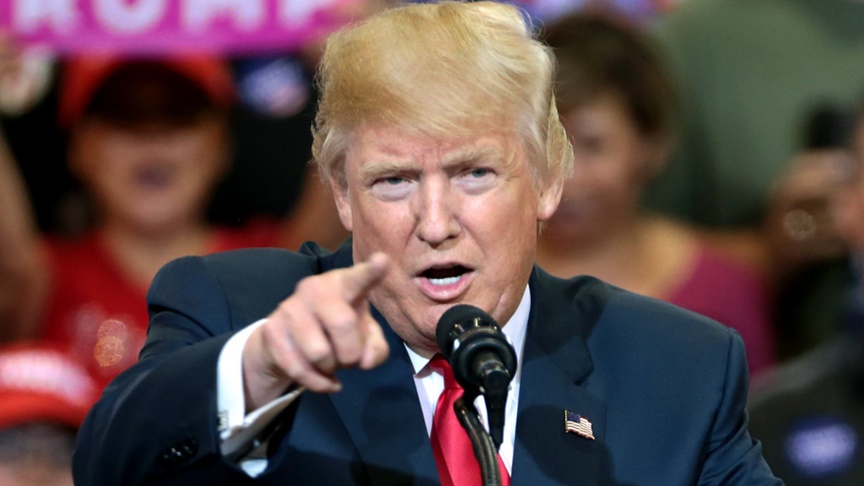US President Donald Trump has signed an executive order introducing several police reforms while rejecting calls to defund or dismantle the police.
His order offers federal grants to improve police practices, including creating a database to trace abuses by officers.
The order comes amid anger over the killing of African Americans by police officers.
Several US cities have proposed more radical reforms.
Speaking at the White House on Tuesday, Mr Trump began by saying he had met a number of African American families who had lost loved ones, including the relatives of Antwon Rose, Botham Jean and Ahmaud Arbery – the black jogger killed in Georgia earlier this year.
No representatives of the families were present with Mr Trump, who spoke while flanked by law enforcement officers.
What did Trump say?
In his address, the president again defended police while condemning looters and “anarchy”.
“We have to find common ground,” Mr Trump said. “But I strongly oppose the radical and dangerous efforts to defund, dismantle and dissolve our police departments.”
He added that “without police, there’s chaos”.
“Americans believe we must support the brave men and women in blue who police our streets and keep us safe,” Mr Trump said.
“Americans also believe we must improve accountability, increase transparency and invest more resources in police training, recruiting and community engagement.”
The latest drive for reform began after the death in police custody of George Floyd last month.
Mr Floyd died after a white police officer in Minneapolis knelt on his neck for almost nine minutes. The killing spurred global protests led by the Black Lives Matter movement.
There was fresh outrage after the death of another black man, Rayshard Brooks, who was shot during an attempted arrest in Atlanta last Friday.
What does the Trump order include?
The Trump announcement comes as Democrats and Republicans in the US Congress are developing reforms of their own.
The president’s executive order aims to provide incentives for police departments to improve by tying some federal grants to “best practices”.
It will create a federal database of complaints against officers. It will also encourage the deployment of social workers alongside officers to deal with non-violent cases involving drug addiction and homelessness.
The White House has stressed the idea is to bring the police closer to communities.
The order will also prioritise federal grants to departments that obtain certifications of high standards regarding de-escalation training and use of force.
“As part of this new credentialing process, chokeholds will be banned except if an officer’s life is at risk,” Mr Trump said. “Everybody said it’s time, we have to do it.”
The president said the government was looking into new “less lethal weapons to prevent deadly interactions”.
Mr Trump has described the Atlanta incident as “very disturbing”, and said his initiative was “about safety”.
The president has also condemned George Floyd’s death, but rejected suggestions of ingrained racism in police forces.
Critics say the measures fall short of the deep reform that many are seeking.
Following the announcement, Senate Democratic leader Chuck Schumer called on lawmakers to pass bolder legislation.
“Unfortunately, this executive order will not deliver the comprehensive meaningful change and accountability in our nation’s police departments that Americans are demanding,” he said.
Top House Democrat Nancy Pelosi said the order “falls sadly and seriously short of what is required to combat the epidemic of racial injustice and police brutality that is murdering hundreds of Black Americans”.
“During this moment of national anguish, we must insist on bold change, not meekly surrender to the bare minimum,” she continued.
The law-and-order president
Analysis by Tara McKelvey, BBC White House correspondent
With the signing of the executive order, Trump caved – a bit.
He has called himself a law-and-order president and taken a hard-line approach on the protestors. But on Tuesday, he spoke of changes within the police force.
He used dramatic language, saying he was concerned about justice. He also described the executive order, saying some officers would, for example, now be accompanied by social workers when they go out to help drug addicts or homeless people.
The executive order was hardly the sweeping reform that activists have called for, however.
The president spoke with even more passion about the economy, and the White House was filled with staffers who were not wearing masks.
They – like the president – were trying to convey the message that the nation and its economy are now returning to its once-healthy self.
What other reforms have been proposed?
In Minneapolis, some council members have announced plans to defund and dismantle the police department.
In Atlanta, following Rayshard Brooks’s death, Mayor Keisha Lance Bottoms demanded a series of changes concerning the use of lethal force by police. These include a “duty to intervene” if a police officer sees misconduct by a colleague.
San Francisco, Los Angeles, New York and Chicago are among the cities that have said they will reform their policies on the use of force, and root out racist officers.
In New York, Governor Andrew Cuomo signed legislation on Tuesday requiring state police troopers to wear body cameras and creating a new office to investigate police misconduct.
At a federal level, the Democrats have introduced their own legislation into the House of Representatives.
It calls for a ban on the chokeholds method of restraining suspects, and a ban on no-knock warrants – which allow police to enter a property without notifying residents.
BBC / Balkantimes.press
Napomena o autorskim pravima: Dozvoljeno preuzimanje sadržaja isključivo uz navođenje linka prema stranici našeg portala sa koje je sadržaj preuzet. Stavovi izraženi u ovom tekstu autorovi su i ne odražavaju nužno uredničku politiku The Balkantimes Press.
Copyright Notice: It is allowed to download the content only by providing a link to the page of our portal from which the content was downloaded. The views expressed in this text are those of the authors and do not necessarily reflect the editorial policies of The Balkantimes Press.

